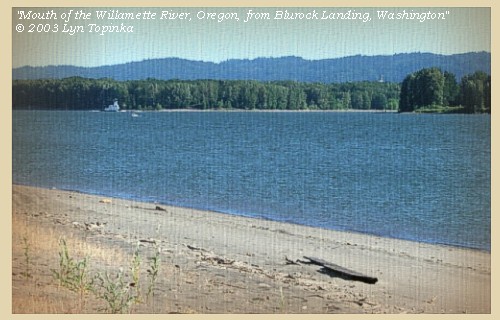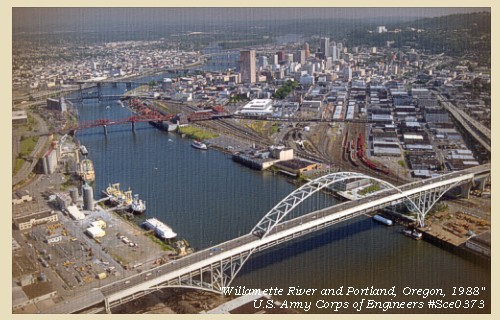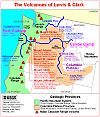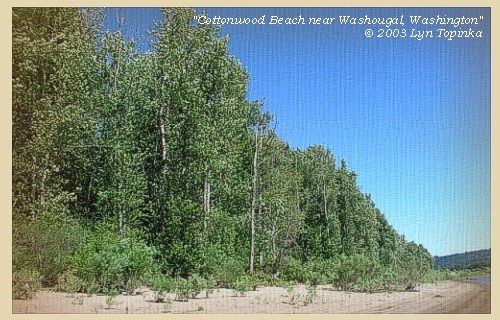
Willamette River:
Most of Oregon's population, technology and
agricultural centers, and important
transportion, power, and communications
lifelines are located in the Willamette Valley
of western Oregon. The lowlands of the
Willamette Valley extend approximately 75 miles
along the Willamette River and contain the
major cities of Portland, Salem, Corvallis,
and Eugene. The valley is part of the
Willamette River drainage basin, which covers
12,300 square miles between the crest of
the Oregon Coast Range on the west and the
Cascade Range to the east. The Willamette
River is the largest river in the valley and
is fed by several major tributaries, including
the McKenzie, Calapooia, Santiam, Tualatin,
Yamhill, and Clakamas Rivers. The valley is
the major source of ground and surface water
for the population centers.
-- Givler and Wells, 2001











- 1814 Map, Lewis and Clark's map of the Columbia River (section of original). (Click to enlarge.) Shows the Willamette River merging from the south (just left of center). The Lewis and Clark name "Multnomah R." has been cropped in this image.
Map also includes three of the five volcanoes Lewis and Clark saw and commented on. While the journals mention the expedition seeing Mount Adams, it does not appear on their map. Mount Jefferson is to the south (bottom) and off the map.
From the "Nicholas Biddle/Paul Allen" 1814 publication.
Original Map: "A Map of Lewis and Clark's Track, Across the Western Portion of North America, From the Mississippi to the Pacific Ocean".
From: History of the expedition under the command of Captains Lewis and Clark : to the sources of the Missouri, thence across the Rocky Mountains and down the river Columbia to the Pacific Ocean : performed during the years 1804-5-6 : by order of the government of the United States / prepared for the press by Paul Allen. Philadelphia : Bradford and Insskeep, 1814.
Harold B. Lee Library, Brigham Young University #upbover maps37.
-- Brigham Young University, Harold B. Lee Library Website, 2004.
- 1833 Map (section of original), Columbia River. (Click to enlarge).
Includes Mount Hood and Mount Jefferson. Note: Mount Baker is depicted (upper middle) but Mounts Adams, Rainier and St. Helens are missing. The Columbia River is shown as "Oregon River" at its mouth and "Columbia or Oregon R." further inland. "Wappatoo Valley" is labeled. Also shows Fort Clatsop ("F. Clatsop or F. George"), the Willamette River ("Multnomah R."), Sandy River ("Quicksand R."), John Day River ("R.La Page"), Walla Walla River ("Wallwullah R."), Snake River ("Lewis R."), and the Yakima River ("Tapete R.").
Original Map: Oregon Territory, 1833.
Creator: Illman & Pilbrow, published by Illman & Pilbrow, New York.
Comments: Illman & Pilbrow is the engraving firm which copyrighted and published this map, the actual artist is unknown.
Washington State University Digital Maps Collection #WSU323.
University of Washington Digital Maps Collection #UW104.
-- Washington State University Early Washington Maps Digital Collection Website, 2004
- 1837 Map, Columbia River with Mount Hood (section of original). (Click to enlarge).
Includes "Wallamant or Multnomah R.".
Original Map: Map of the Territory West of the Rocky Mountains (1837)
Author: Washington Irving, Publisher: Philadelphia, Carey, Lea, & Blanchard.
Washington State University Archives #WSU555.
-- Washington State University Early Washington Maps Digital Collection Website, 2004
- 1849 Map (section of original), Alexander Ross's Columbia River. (Click to enlarge).
Original Map: Map of the Columbia to illustrate Ross's adventures.
Author: Alexander Ross; Publication Date: 1849; Publisher: London, Smith, Elder and Co., 1849.
Washington State University Archives #WSU478.
-- Washington State University Early Washington Maps Digital Collection Website, 2004
- 1853 Map, Washington and Oregon and the Columbia River,
from the Clearwater River to the Snake River and down the Columbia River to the Pacific Ocean (section of original). (Click to enlarge).
Includes: Clearwater River (Kooskooski), Lapwai Creek (Lapwai R.), Snake River (Saptin or Lewis R.), Columbia River (Columbia R.), Yakima River (Yakima R.), Walla Walla River (Wallawalla R.), Umatilla River (Umatilla R.), Willow Creek (Quesnells R.), John Day River (John day's R.), Deschutes River (Fall R.), Willamette River (Willammette R.), and Cowlitz River (Cowlitz R.).
Original Map: "Map of California, Oregon, Washington, Utah, and New Mexico (1853)",
by Thomas Cowperthwait & Co.
Washington State University Archives #WSU22.
-- Washington State University Library Collections Website, 2003
- 1853-54 Map, Columbia River, including the Fort Vancouver area (section of original). (Click to enlarge).
Includes Longview, Washington (Monticello), Coweeman River (Minter R.), Kalama River (Ca-la-ma R.),
Lewis River (Cath-la-pootle R.), Willamette River, Fort Vancouver, Cape Horn, and "The Cascades". Vancouver Lake is depicted but not labeled.
Original Map: "Rocky Mountains to Puget Sound : from explorations and surveys / made under the direction of the Hon. Jefferson Davis, Secretary of War by Isaac I. Stevens Governor of Washington Territory, 1853-4."
Inset: (Supplementary sketch) Reconnaissance of the railroad route from Wallawalla to Seattle via Yak-e-mah River & Snoqualmie Pass. By A. W. Tinkham in January 1854. Drawn by J. R. P. Mechlin. 20 x 28 cm.
Topographer, John Lambert, Published in Washington D.C., 1859, 1:1,200,000, Notes: From the U.S. War Department, Explorations and Surveys for a Railroad Route from the Mississippi River to the Pacific Ocean, Topographical Maps, to Illustrate the Various Reports, U.S. Library of Congress American Memories Reference "LC Railroad Maps #156".
-- U.S. Library of Congress, American Memories Website, 2004
- 1855 Map, Columbia River from Vancouver to the Pacific (section of original). (Click to enlarge).
Original Map: "Map of Oregon and Washington Territories:
showing the proposed Northern Railroad route to the Pacific Ocean,
by John Disturnell, 1855.
University of Washington Archives #UW155.
-- University of Washington Library Collections Website, 2002
- 1887 Map (section of original),
Columbia River and the Portland and Vancouver vicinity, including the Willamette River. (Click to enlarge).
Original Map: The Columbia River from Celilo to the mouth showing locations of the salmon fisheries, 1887.
Scale ca. 1:375,000, Relief shown by hachures.
U.S. Army Corps of Engineers, Engineer Office, G.P.O. 1888.
University of Washington Archives #UW128.
-- University of Washington Library Archives Website, 2002
- 1988 Map, Mouth of the Willamette River and Vancouver Lake (section of original). (Click to enlarge).
Office of Coast Surveys, Historical Maps and Charts,
Columbia River, Saint Helens to Vancouver, 1988, Chart#18524, 1:40,000.
-- NOAA Office of Coast Survey Website, 2004
- 1992, NASA Image, Columbia River, Portland, Oregon, and Vancouver, Washington (section of original). (Click to enlarge).
View from space - west-looking, low-oblique photograph,
showing a section of the Columbia River with Government Island, the Sandy River, Portland, Oregon, and Vancouver,
Washington, September 1992. The Columbia River is flowing from bottom (east) to top (west).
NASA Earth from Space #STS047-096-066.
-- NASA Earth from Space Website, 2002
- 2003, Mouth of the Willamette River, Oregon, as seen from Blurock Landing, Washington. (Click to enlarge).
Copyright © 2003 Lyn Topinka, private archives, used with permission.

Portland, Oregon:
In 1843, Tennessee drifter William Overton and Massachusetts lawyer Asa Lovejoy beached their canoe on the banks of the Willamette River. Overcome by the beauty of the area, Overton saw great potential for this mountain-ringed, timber-rich land. His only problem was that he lacked the 25 cents needed to file a land claim. So, he struck a bargain with Lovejoy -- In return for a quarter, Overton would share his claim to the 640-acre site known as "The Clearing." Soon bored with clearing trees and building roads,
Overton drifted on, selling his half of the claim to Francis W. Pettygrove. The new partners, Lovejoy and Pettygrove, couldn't decide on a name for their new township. Lovejoy was determined to name the site after his hometown of Boston, Massachusetts, while Pettygrove was equally adamant about his native Portland, Maine. They decided to flip a coin, now known as the "Portland Penny", to settle the argument. Pettygrove won on two tosses out of three. Lovejoy and Pettygrove were confident that Portland, with its deep water and abundant natural resources, would one day become a popular and prosperous port. Portland was officially incorporated on February 8, 1851, and today covers 130 square miles.
-- Portland, Oregon Visitor's Association Website, 2003


- 1853 Map, Washington and Oregon and the Columbia River,
from the Clearwater River to the Snake River and down the Columbia River to the Pacific Ocean (section of original). (Click to enlarge).
Includes: Clearwater River (Kooskooski), Lapwai Creek (Lapwai R.), Snake River (Saptin or Lewis R.), Columbia River (Columbia R.), Yakima River (Yakima R.), Walla Walla River (Wallawalla R.), Umatilla River (Umatilla R.), Willow Creek (Quesnells R.), John Day River (John day's R.), Deschutes River (Fall R.), Willamette River (Willammette R.), and Cowlitz River (Cowlitz R.).
Original Map: "Map of California, Oregon, Washington, Utah, and New Mexico (1853)",
by Thomas Cowperthwait & Co.
Washington State University Archives #WSU22.
-- Washington State University Library Collections Website, 2003
- 1988 view of the Willamette River and the city of Portland, Oregon. Looking south with the Fremont Bridge in the foreground. (Click to enlarge). U.S. Army Corps of Engineers Photograph #Sce0373. Photograph Date: June 1988. Photographer: Bob Heims.
U.S. Army Corps of Engineers Photo Archives.
-- U.S. Army Corps of Engineers Website, 2002
|




















